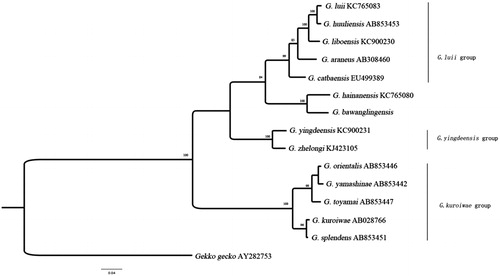Abstract
To date, only a single complete mitochondrial genome sequence has been reported for species in the genus Goniurosaurus. In this study, using Illumina sequencing data, we assembled the complete mitochondrial genome of Goniurosaurus bawanglingensis, which consists of 16,982 base pairs, comprising 13 protein-coding genes, 2 ribosomal RNA genes, 22 tRNA genes, and non-coding regions (D-Loop), and has an overall A + T content of 61.65%. Using partial sequence data of the 16S rRNA gene of 14 Goniurosaurus species, including G. bawanglingensis, we reconstructed the phylogeny of the genus Goniurosaurus.
Keywords:
The genus Goniurosaurus (Squamata: Sauria: Eublepharidae) comprises 18 species of primarily nocturnal lizards that are mostly associated with rocky/karst topography and are distributed throughout northern Vietnam, southern China, islands in the Beibu Gulf of the South China Sea, and the Ryukyu Archipelago of Japan (Zhou et al. Citation2018). To date, however, the taxonomy and phylogeny of the genus Goniurosaurus remained unresolved and contentious. Blair et al. (Citation2009) have proposed that further molecular analyses are needed if we wish to gain a better understanding of the taxonomy and evolutionary history of this genus, and in this regard, mitogenome analysis has been successfully applied to resolve the phylogenetic relationships among various groups of different taxonomic ranks.
Goniurosaurus bawanglingensis is a species endemic to Hainan Island, China (Grismer et al. Citation2002), where it mainly inhabits areas surrounding limestone forest caves, near karst cliffs, and primary shrub vegetation on limestone (Grismer et al. Citation1999, Citation2002). On the basis of a search of the National Center for Biotechnology Information (NCBI) database, we assumed that the mitogenome of G. bawanglingensis has yet to be sequenced, and therefore to further our understanding of species in the genus Goniurosaurus, we determined the complete mitogenome sequence of G. bawanglingensis.
DNA was extracted using the standard phenol–chloroform method from the tail of a G. bawanglingensis specimen (voucher number: HNNU2017052704) collected from the type locality, Bawangling National Nature Reserve, on Hainan Island (19°07′08.10′′N, 109°09′07.20′′E). The tail and remainder of the specimen have been preserved in 95% ethanol at the College of Life Sciences, Hainan Normal University. The complete mitogenome sequence of G. bawanglingensis was determined using high-throughput sequencing technology.
The complete mitogenome of the G. bawanglingensis is 16,982 bp in length with a 61.65% A + T content. The genome contains the typical component of 13 protein-coding genes, 2 ribosomal RNA genes, 22 tRNA genes, and non-coding regions (D-Loop). The arrangement of the protein-coding and ribosomal RNA genes is similar to that found in typical vertebrates.
The phylogeny of 14 Goniurosaurus species, including G. bawanglingensis, was reconstructed based on partial nucleotide sequence data of the 16S rRNA gene using Bayesian inference (BI) methods implemented with MrBayes (version 3.2.2). The resultant BI tree distinctly showed that G. bawanglingensis and G. hainanensis form a sister group, and that the clade clusters in a monophyletic group with five species of G. luii group; G. yingdeensis, and G. zhelongi constitute the G. yingdeensis group; and five Goniurosaurus species from the Ryukyu Islands constitute the G. kuroiwae group ().
Disclosure statement
No potential conflict of interest was reported by the authors.
References
- Blair C, Orlov NL, Shi HT, Murphy RW. 2009. A taxonomic re-evaluation of Goniurosaurus hainanensis (Squamata: Eublepharidae) from Hainan Island, China. Russ J Herpetol. 16:35–40.
- Grismer LL, Shi H, Orlov NL, Ananjeva NB. 2002. A new species of Goniurosaurus (Squamata: Eublepharidae) from Hainan Island, China. J Herpetol. 36:217–224.
- Grismer LL, Viets BE, Boyle LJ. 1999. Two new continental species of Goniurosaurus (Squamata: Eublepharidae) with a phylogeny and evolutionary classification of the genus. J Herpetol. 33:382–393.
- Zhou R, Wang N, Chen BL, Liang B. 2018. Morphological evidence uncovers a new species of Goniurosaurus (Squamata: Eublepharidae) from Hainan Island, China. Zootaxa. 4369:281–291.

